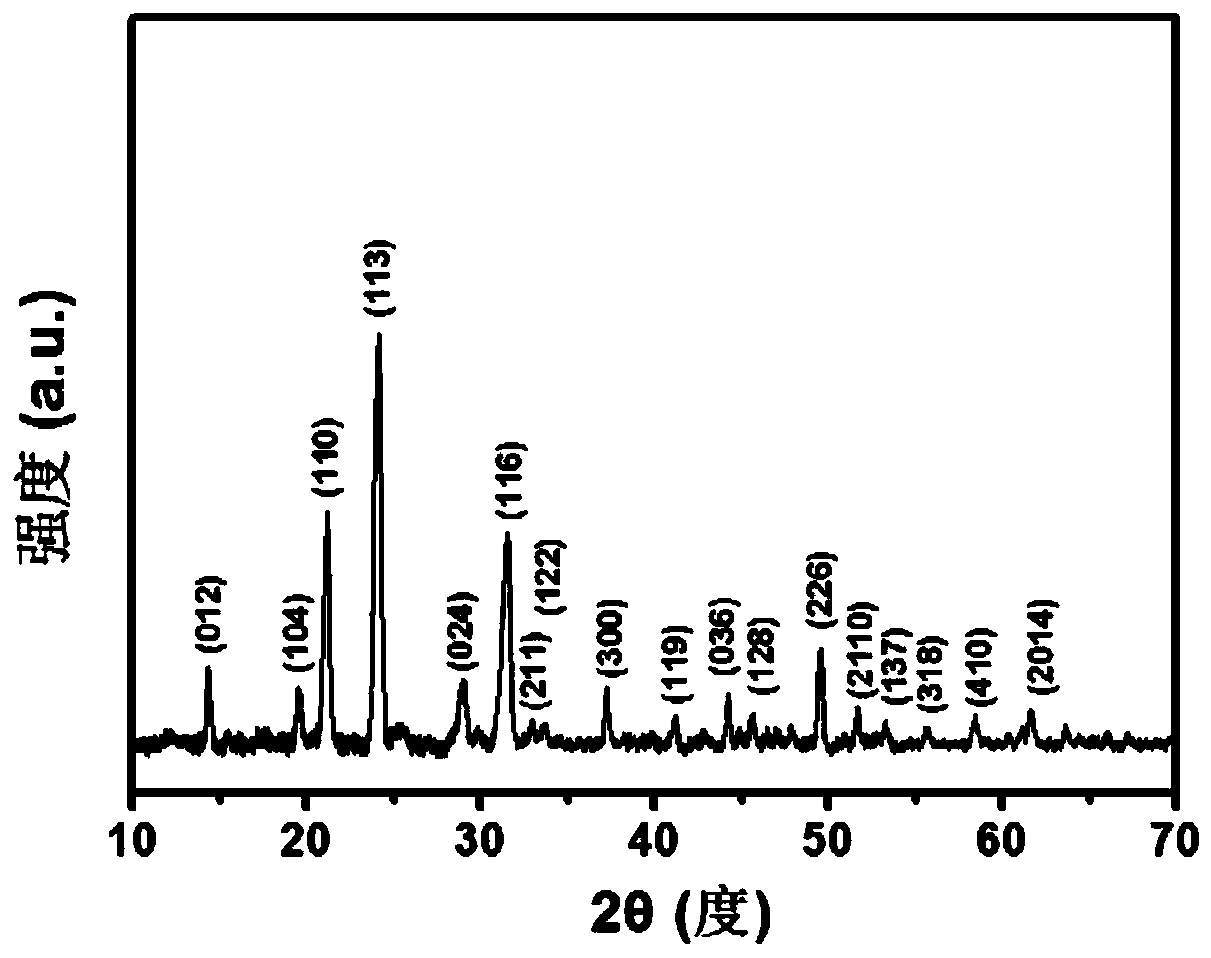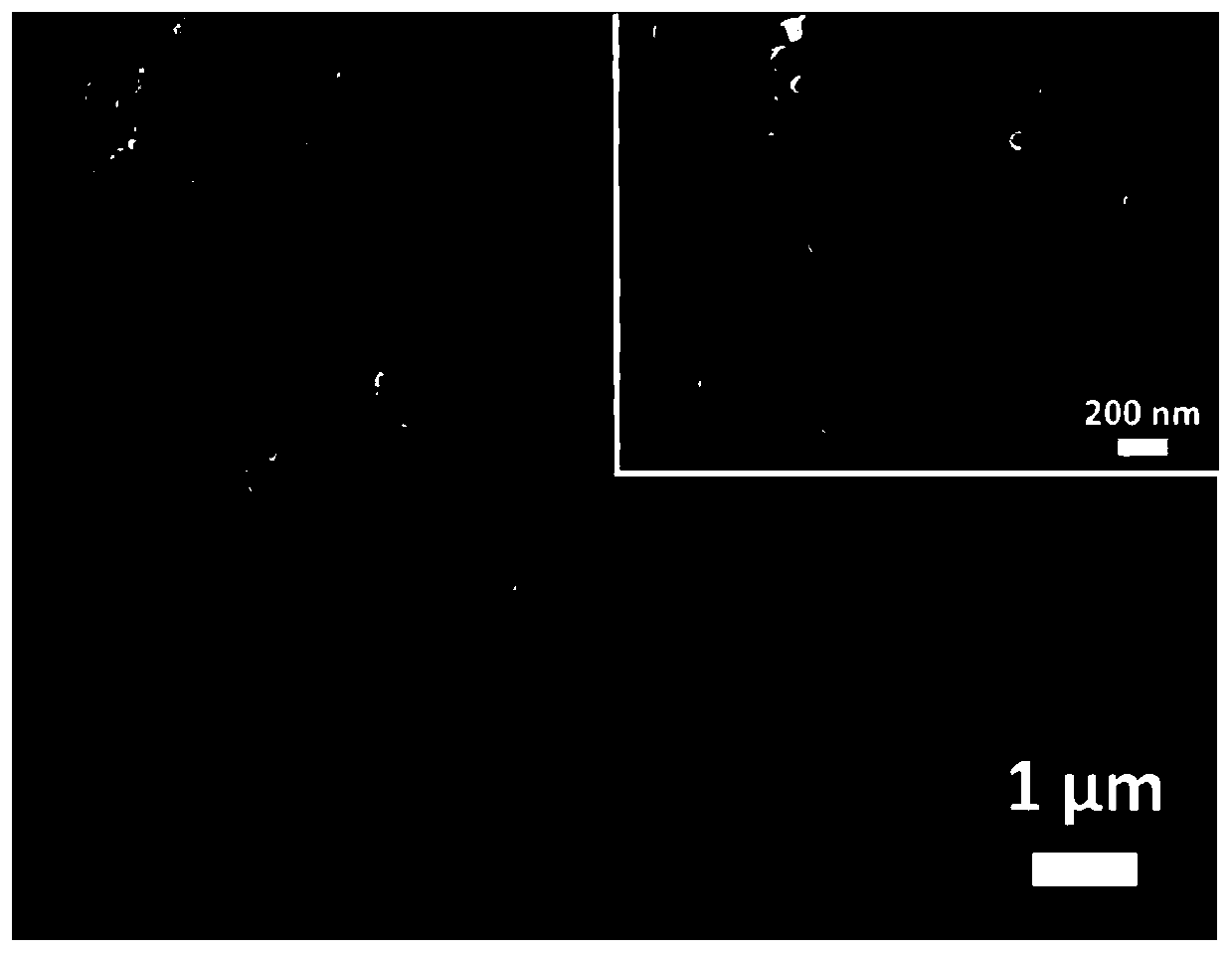Carbon-coated titanium potassium phosphate nanoparticles and its preparation method and application
A nanoparticle and carbon-coated technology, applied in nanotechnology, nanotechnology, nanotechnology, etc. for materials and surface science, to achieve the effects of improving electronic conductivity, excellent rate performance, and mild conditions
- Summary
- Abstract
- Description
- Claims
- Application Information
AI Technical Summary
Problems solved by technology
Method used
Image
Examples
Embodiment 1
[0026] Carbon Coated KTi 2 (PO 4 ) 3 A method for preparing nanoparticles, comprising the steps of:
[0027] 1) Dissolve 3mmol of phosphoric acid in a mixed solution of 30mL of ethanol and 30mL of ethylene glycol, and stir until uniformly mixed.
[0028] 2) Add 2 mmol of potassium acetate and 1 mmol of tetrabutyl titanate to the mixed solution obtained in step 1) in sequence, and stir for 2 hours.
[0029] 3) The product obtained in step 2) is centrifugally filtered, the precipitate is washed twice with alcohol, and dried at 70° C. to obtain the precursor.
[0030] 4) Put the precursor obtained in step 3) into a tube furnace, heat it up to 750°C in argon and keep it warm for 2 hours, and then naturally cool to room temperature to obtain carbon-coated KTi 2 (PO 4 ) 3 nanoparticles.
[0031] KTi coated with carbon of this example 2 (PO 4 ) 3 Nanoparticles as an example, the structure of which is determined by X-ray diffractometer. like figure 1 As shown, the X-ray di...
Embodiment 2
[0035] Carbon Coated KTi 2 (PO 4 ) 3 A method for preparing nanoparticles, comprising the steps of:
[0036] 1) Dissolve 3mmol of phosphoric acid in a mixed solution of 30mL of ethanol and 30mL of ethylene glycol, and stir until uniformly mixed.
[0037] 2) Add 2 mmol of potassium acetate and 1 mmol of tetrabutyl titanate to the mixed solution obtained in step 1) in sequence, and stir for 2 hours.
[0038] 3) The product obtained in step 2) is centrifugally filtered, the precipitate is washed twice with alcohol, and dried at 70° C. to obtain the precursor.
[0039] 4) Put the precursor obtained in step 3) into a tube furnace, heat it up to 750°C in argon and keep it warm for 2 hours, and then naturally cool to room temperature to obtain carbon-coated KTi 2 (PO 4 ) 3 nanoparticles.
[0040] KTi coated with product carbon of the present invention 2 (PO 4 ) 3 Nanoparticles, for example, are small particles with a diameter of 100-200 nanometers.
[0041] With the carbon...
Embodiment 3
[0043] Carbon Coated KTi 2 (PO 4 ) 3 A method for preparing nanoparticles, comprising the steps of:
[0044] 1) Dissolve 3mmol of phosphoric acid in a mixed solution of 25mL of ethanol and 30mL of ethylene glycol, and stir until uniformly mixed.
[0045] 2) Add 2 mmol of potassium acetate and 1 mmol of tetrabutyl titanate to the mixed solution obtained in step 1) in sequence, and stir for 2 hours.
[0046] 3) The product obtained in step 2) is centrifugally filtered, the precipitate is washed twice with alcohol, and dried at 70° C. to obtain the precursor.
[0047] 4) Put the precursor obtained in step 3) into a tube furnace, heat it up to 750°C in argon and keep it warm for 2 hours, and then naturally cool to room temperature to obtain carbon-coated KTi 2 (PO 4 ) 3 nanoparticles.
[0048] KTi coated with product carbon of the present invention 2 (PO 4 ) 3 Nanoparticles, for example, are small particles with a diameter of 100-200 nanometers.
[0049] With the carbon...
PUM
| Property | Measurement | Unit |
|---|---|---|
| size | aaaaa | aaaaa |
| thickness | aaaaa | aaaaa |
| diameter | aaaaa | aaaaa |
Abstract
Description
Claims
Application Information
 Login to View More
Login to View More - R&D
- Intellectual Property
- Life Sciences
- Materials
- Tech Scout
- Unparalleled Data Quality
- Higher Quality Content
- 60% Fewer Hallucinations
Browse by: Latest US Patents, China's latest patents, Technical Efficacy Thesaurus, Application Domain, Technology Topic, Popular Technical Reports.
© 2025 PatSnap. All rights reserved.Legal|Privacy policy|Modern Slavery Act Transparency Statement|Sitemap|About US| Contact US: help@patsnap.com



